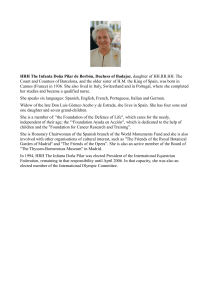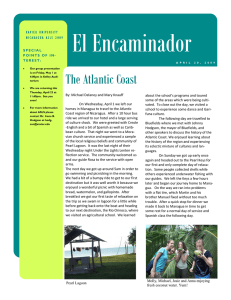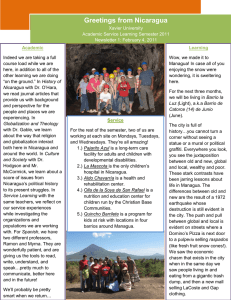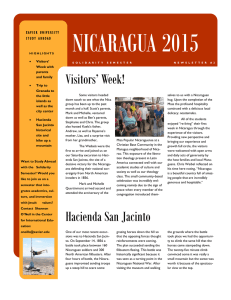to reflect on the seven the priest and the don-
advertisement
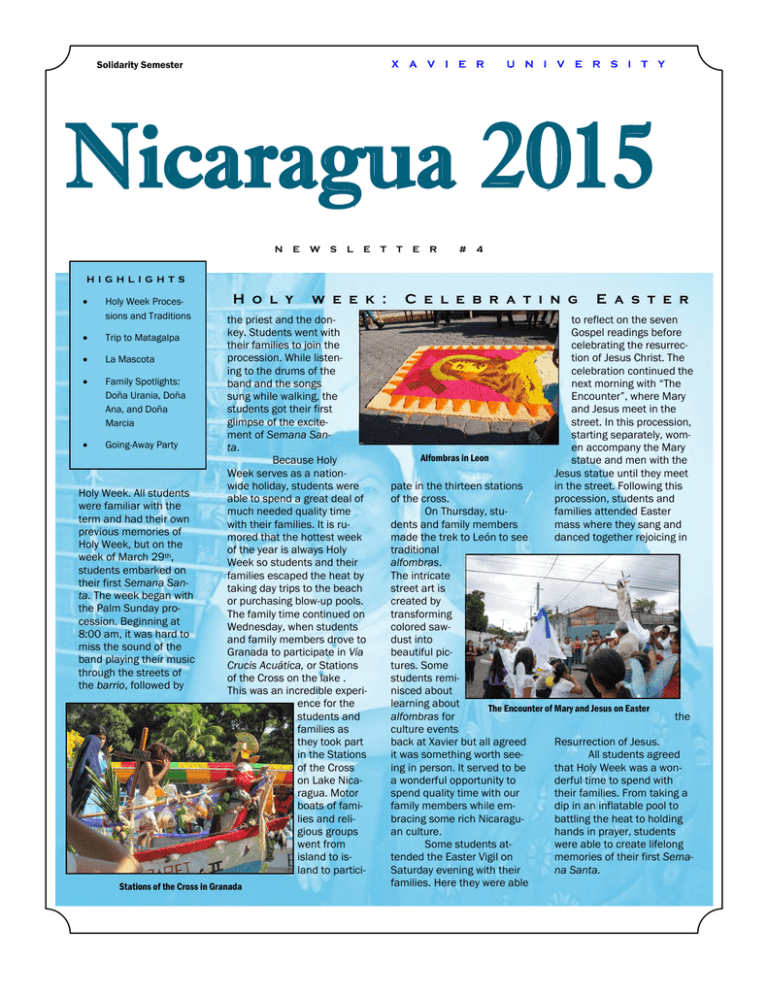
X A V I E R Solidarity Semester U N I V E R S I T Y Nicaragua 2015 N E W S L E T T E R # 4 H I G H L I G H T S Holy Week Processions and Traditions Trip to Matagalpa La Mascota Family Spotlights: Doña Urania, Doña Ana, and Doña Marcia Going-Away Party Holy Week. All students were familiar with the term and had their own previous memories of Holy Week, but on the week of March 29th, students embarked on their first Semana Santa. The week began with the Palm Sunday procession. Beginning at 8:00 am, it was hard to miss the sound of the band playing their music through the streets of the barrio, followed by H o l y w e e k : the priest and the donkey. Students went with their families to join the procession. While listening to the drums of the band and the songs sung while walking, the students got their first glimpse of the excitement of Semana Santa. Because Holy Week serves as a nationwide holiday, students were able to spend a great deal of much needed quality time with their families. It is rumored that the hottest week of the year is always Holy Week so students and their families escaped the heat by taking day trips to the beach or purchasing blow-up pools. The family time continued on Wednesday, when students and family members drove to Granada to participate in Vía Crucis Acuática, or Stations of the Cross on the lake . This was an incredible experience for the students and families as they took part in the Stations of the Cross on Lake Nicaragua. Motor boats of families and religious groups went from island to island to partici- Stations of the Cross in Granada C e l e b r a t i n g Alfombras in Leon E a s t e r to reflect on the seven Gospel readings before celebrating the resurrection of Jesus Christ. The celebration continued the next morning with “The Encounter”, where Mary and Jesus meet in the street. In this procession, starting separately, women accompany the Mary statue and men with the Jesus statue until they meet in the street. Following this procession, students and families attended Easter mass where they sang and danced together rejoicing in pate in the thirteen stations of the cross. On Thursday, students and family members made the trek to León to see traditional alfombras. The intricate street art is created by transforming colored sawdust into beautiful pictures. Some students reminisced about learning about The Encounter of Mary and Jesus on Easter alfombras for the culture events back at Xavier but all agreed Resurrection of Jesus. it was something worth seeAll students agreed ing in person. It served to be that Holy Week was a wona wonderful opportunity to derful time to spend with spend quality time with our their families. From taking a family members while emdip in an inflatable pool to bracing some rich Nicaragubattling the heat to holding an culture. hands in prayer, students Some students atwere able to create lifelong tended the Easter Vigil on memories of their first SemaSaturday evening with their na Santa. families. Here they were able P a g e 2 N i c a r a g u a 2 0 1 5 Weekend Excursion: Matagalpa Our arrival in Matagalpa was met with cool air and a warm welcome from Sister Rebecca (Becky), a nun from the Sisters of St. Mary of Namur who serves the Matagalpinos. The nuns there have felt a special call to serving individuals with disabilities and their families, and we had the opportunity to visit the park they constructed specifically for those with disabilities, as well as the yogurt and cheese shop opened by some of the mothers of children with disabilities. We traveled farther into the mountains to San Ramón to spend the afternoon at an impressive, family-run farm, Finca San Martín. We conversed with the owner, Martín, about his family’s previous chal- Mirka contemplates pictures of the Nicaraguan heroes and martyrs lenges with land disputes, his work as a mediator of minor disputes in the community, and the agroecological structure of his family’s self-sustainable farm. Upon touring the farm, we were able to see the rows of coffee plants, areas of reforestation, herbs, and several sloths. After dining at a restaurant operated by the mothers of children with disabilities, we ended the night with a short film documenting Benjamin Linder’s influence in Nicaragua, an American engineer who dedicated his time and skills to bringing electricity to rural parts of Nicaragua. Sunday morning greeted us with a delicious breakfast at the Casa Materna, a place in Matagalpa that houses pregnant women from the mountains with risky pregnancies or those who are nearing their due date. Homes like this one allow women in remote areas the possibility of giving birth in a hospital (rather than having a homebirth), thus protecting both the mother and her baby from possible complications. The women shared their stories with us, including the amount of time each traveled in order to arrive at Casa Mater- na; many walked or rode a mule or horse for an hour or two before traveling several hours in a vehicle to the home! We spent the mid-morning with the Mothers of Heroes and Martyrs, a group of women who organized in the 1970s after their children were “disappeared” or killed by the National Guard. These strong women shared their history and stories with us, joining together as a way of commemorating their lost ones. The group then transitioned to commemorating the life and death of Ben Linder by visiting his grave site in Matagalpa and reading an excerpt from a diary of a fellow international worker who knew Ben well. Lunch prepared by Martín’s family L a The final service site where m a s c o t a Martín detailing his farming decisions students worked was La Masco- Violeta Marin. La Mascota is the only children’s hospital in Nicaragua, provid- in the children’s oncology and hematology department. While there, Rayanne and Alex ta Children’s hospital. Stu- ing families from all parts of the country dents Rayanne Pancoast and Alex Fath worked there and with free services. With the help of donations from charities and organizations, were able to play with patients and learn about the importance of “Game Thera- enjoyed their time there. They were able connect with patients La Mascota is also able to help provide transportation and housing for families were able to create relationships with the children, providing some much needed play and their families as well as their supervisor, social worker traveling from all over the country. time and individual attention. Rayanne and Alex served as volunteers py”. While working at La Mascota, students S o l i d a r i ty S e m e st e r P a g e D o ñ a If you ever find yourself in Barrio La Luz and stumble upon a salmon colored house, with a white fence- chances are you will hear the shrieks and shrills of two little girls accompanied by adult voices chattering about neighborhood and family drama. At the center of it all is D o ñ a Whether you find her deep in prayer at church, in the kitchen making refresco or relaxing watching her favorite telenovela, you can always find a smiling face on the loving Doña Ana. Doña Ana, or Anita, and her husband Don José have lived in Barrio del Luz for almost forty years. Together they have raised six children and have nine grandchildren 3 U r a n i a Doña Urania. A vibrant woman who will welcome you into her home with open arms and the story of her latest ataque de risa. With 5 children and a loving husband she already has a large family to look after and with Xavier student Dajah Siplin, the family count totaled 8 during our semester. Growing up as an only child Dajah said that this experience was very difficult for her (expand), but that Doña Urania made her experience very comfortable and created a welcoming atmosphere in her home. One of her favorite memories Dajah says is sitting in their front porch area and talking about life, religion, boys, and daily events with her older host sister and host mom: "she always had something funny to say and was always laughing about something. She is just such a happy person." Doña Urania is married to Don Jorge and together they have 2 sons Jorge (25), Chris (15), and three daughters, Maria Fernanda (20), Naomi (6) and Luciana (3). A n a and one great-grandson. Recently, however, Doña Ana has added another daughter to her family while she hosts Alex Fath. Doña Ana’s constant smile and loving laugh could make anyone feel welcome in her beautiful abode. She takes care of her household by waking up everyday at 5:30 am to fill up buckets of water and preparing breakfast D o ñ a All of the mothers housing students in Barrio La Luz are incredible women, and Doña Marcia is no exception. She is a strong Catholic woman who enjoys spending time in conversation with others, and you will rarely find her without a smile on her face. Marcia is a single mother of two exceptional children, Mario (21) and Daniela (11), and has now GROUP QUOTE for Don José. Throughout the day she works without complaint to keep the house functioning. As she reminded Alex: “Life is hard but beautiful’. Her continual love for God serves as an inspiration for those who meet her and her adoring smile makes one feel at home. M a r c i a welcomed Kaela Allton into the family. She works in the call center of a bank during the week, and when she is home, she cleans, cooks, takes care of the house, cares for her children, or reads the newspaper. Kaela describes Marcia as an incredibly strong, caring, and fun-loving woman who has many life lessons to teach. What she admires most about her host mother is that she raises her children to be "people of conscience," or people who take responsibility for others, and she serves as a wonderful example for her kids. This woman’s laugh is contagious, and she has the ability to find a reason to smile in any situation. JOIN THE EXPERIENCE! I N T E R E S T E D I N PA R T I PAT I N G I N T H E S O L I DA R I T Y S E M E S T E R ? Contact: Shannon O’Neill Study Abroad Assistant Email: oneillsm@xavier.edu Phone: (513) 745-3782 D e s p e d i da : Like she did at the Welcome Party at the beginning of the year, Doña Nieves led the attendees in prayer, although this time the Nicaragua family had increased in size. In addition to the attendance of the host families, those present included teachers, friends (new and old), doctors, drivers, and all those who make the program possible. Following Nieves’ words, the group entertained its audience in presenting a few typical Nicaraguan dances they had learned in dance class. In celebration of Scott’s birthday, the families presented him with a piñata, which all the T h e G o i n g - Away kids (and adults) enjoyed. The party served as a time for the families to celebrate their newest additions, but also for the students to say thank you and goodbye to those who had welcomed them into their country, homes, and Pa r t y hearts. The students presented stunning flower baskets made by women in Nindirí to all those who had contributed to the success of the program as well as a coffee mug displaying a picture of the group. Students and families exchanged hugs and tears as they expressed how meaningful these three months have been. Dancing typically ensues at the end of these parties, but good-byes took precedence. The lovely “ladies” and their dance teacher, Zoila.
